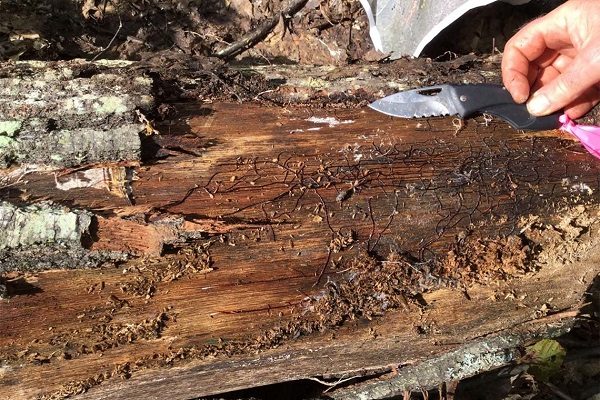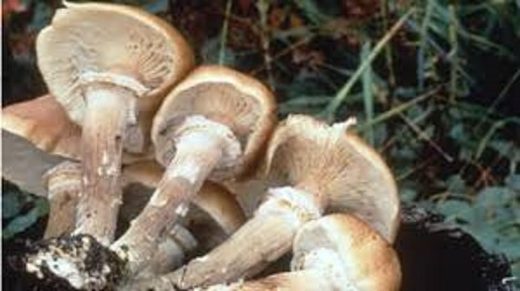
© James B. AndersonEvidence of the Armillaria gallica fungus on a scrap of wood.
It's nicknamed the "humongous fungus"-an unusually large fungal growth belonging to a single genetic individual. An updated analysis of this gigantic fungal beast shows it's substantially larger and older than scientists initially thought.
This single genetic individual, known as C1, belongs to a species of fungus called
Armillaria gallica, otherwise known as the honey mushroom. When University of Toronto biologist James B. Anderson first studied this large growth in 1992, he was astounded by its sheer size. Anderson and his colleagues estimated that it was 1,500 years old, weighed 100,000 kilograms (110 tons) and covered around 37 acres (15 hectares) of forest floor in Michigan's Upper Peninsula.
The C1 specimen, which has latched onto hundreds, if not thousands, of tree roots, was declared to be among the largest and oldest organisms on Earth.Nearly 30 years later, and as a final scientific act before his retirement, Anderson decided to return to the Michigan forest to take more precise measurements of C1 and to see if its cells had changed over the decades.
Looking at hundreds of samples taken from 2015 to 2017, Anderson had to revise his earlier estimates. As he points out in his updated study,
the gigantic fungus is actually closer to 2,500 years old and it weighs around 400,000 kilograms, or 440 tons. The growth covers about 173 acres (70 hectares), which is roughly the same size as the total floor area of the Pentagon building.
"I view these estimates as the lower bound," said Anderson in a statement. "The fungus could actually be much older. However, we think we have circumscribed its entire dimensions, which wasn't the case in 1992."
Like other fungi,
A. gallica sprouts mushrooms on the forest floor, but this species also utilizes a subterranean network of mycelium-underground tendrils that sustain the oversized organism by searching and latching onto sources of food.

© James B. AndersonA. gallica sprouting as honey mushrooms on the forest floor.
Fungi, as you may recall from grade 4 science class, aren't capable of photosynthesis, instead having to obtain food by growing on other living or dead organisms, such as decaying plant or animal matter. The tendrils of
Armillaria fungi are equipped with an organ called rhizomorphs, and
A. gallica's rhizomorphs can suck nutrients from living wood. And in fact, this species is known to infect living trees, and then continue to feed off the decaying matter. Anderson says A. gallica has "a large role in decaying wood and in causing root disease."In addition to characterizing the size, weight, and age of C1, Anderson also studied its cells, which were compared to a reference genome of
A. gallica. Analysis of over 245 cell samples showed that DNA mutation rates in the C1 individual are exceptionally low. Some mutations were observed, but they didn't seem to influence the health of the fungus or its appearance.
"What we think that tells us is that there must be some mechanism by which the fungus protects itself from mutations," said Anderson.
That mechanism somehow allows the fungus to localize mutations in areas where they don't cause much damage. In the paper, Anderson and his colleagues speculate that this mechanism prevents deleterious mutations from occurring in parts of the rhizomorphs responsible for perpetuating the organism's ongoing growth and development. Learning more about this process, the researchers argue, could lead to developments in cancer research.
"It could be an interesting point of comparison," said Anderson. "Cancer is so unstable, mutates at a high rate, and is prone to genomic changes, while
A. gallica is a very persistent organism with few mutations."
The study still needs to go through peer review, but it's
currently available at the the biorxiv preprint server.
As a final aside,
the humongous fungus of Michigan, while large, is not the world's largest creature. That distinction goes to an individual growth ofArmillaria ostoyae in eastern Oregon, which covers 2,385 acres of the Malheur National Forest. This particular individual is estimated to be anywhere from 2,400 to 8,650 years old. Or, by another measure, the largest organism could be the 13-million-pound clonal aspen forest of Utah, which, sadly, is now dying.
Reader Comments
to our Newsletter